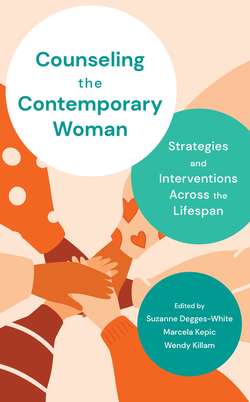Читать книгу Counseling the Contemporary Woman - Suzanne Degges-White - Страница 48
Relational-Cultural Therapy Techniques
ОглавлениеAs described throughout this chapter, RCT is a paradigm shift from an individualistic perspective to therapy founded on connections and diverse meaningful relationships as a basis for developmental growth. Change is not believed to be the result of specific therapeutic techniques; rather, a high quality of engagement between the client and counselor provides the foundation for the counseling process (Frey, 2013; Haskins & Appling, 2017). Counselors are encouraged “to think beyond symptom reduction and remedial helping interventions” (Comstock et al., 2008, p. 280), and presenting concerns and movement toward growth are conceptualized from a strength-based and relational perspective (Frey, 2013). While the theory is grounded in more of a perspective shift, some specific practices can help facilitate the growth process.
A GFR is an essential part of the therapeutic process. While creating this relationship is not a technique in and of itself, the development of this connection requires the use of the principles of mutuality, mutual empathy, and therapeutic authenticity (Duffey & Somody, 2011). To build the deep trust of a GFR, the counselor must practice mutuality and mutual empathy, letting the client know that they have truly affected the counselor. This movement into mutuality is prompted by the counselor’s authenticity and openness to being changed. Using these techniques is essential to building a GFR and the RCT therapeutic process.
The RCT therapeutic process also utilizes a psychoanalytic component (Frey, 2013; Jordan, 2018), employing a retrospective perspective to evaluate ongoing relational patterns and explore their origin before making plans to re-create patterns of relating (Duffey & Somody, 2011). The technique of carefully exploring the past is an essential part of the assessment phase as a counselor gathers information to understand the client and finds discrepancies from current relational images. A counselor may explore a turbulent mother–daughter relationship where a client felt rejected by their mother and then seek exceptions to this way of relating. For instance, have there been other motherlike figures or mentors in the client’s life who were accepting? If so, the counselor would explore these exceptions to help the client re-create their expectation of a motherlike figure from rejection to acceptance. The process of exploring, evaluating, and rationally using past experiences to make changes can help clients move from “shame-based and mistrustful interpersonal impasses and disconnections and back into transformative connections” (Comstock et al., 2008, p. 283). Asking about and processing the past provides opportunities for healing for a client and information to re-create new relational plans.
Developing a client’s relational awareness involves discussions in counseling and practice outside of sessions. A client must better understand their past and also be aware in the present to avoid the re-creation of past ineffective patterns and make long-term, sustained changes. Gaining this skill “is the first step in developing more sophisticated relational capacities that enable one to identify, deconstruct, and resist disconnections and obstacles to mutual empathy in counseling relationships and in the broader culture” (Comstock et al., 2008, p. 202).
Working through disconnections (Duffey & Somody, 2011), which are an unavoidable part of all relationships, including the client–counselor relationship (Comstock et al., 2008), is another essential technique. Counselors must develop a strong awareness of the onset of disconnections in sessions and be comfortable with addressing these uncomfortable rifts. Through honest confrontation of uncomfortable experiences, within the context of a GFR, clients are able to learn the skills necessary to work through disconnections in their own life and build the stronger connections that result.
Lastly, the RCT therapy process can often benefit from creative interventions (Duffey & Somody, 2011). Creative techniques in and of themselves can provide clients with a different way of viewing the world (Gladding, 2016). The use of creative arts can stimulate a client, provide memorable experiences, and also engage a different part of the brain than typically used in talk therapy. This movement toward a holistic counseling experience can facilitate a vulnerable experience for clients and provide a viable platform for clients and counselors to work together toward an end goal.
While RCT is not a technique-driven theory, the conscious use of specific skills can facilitate the development of a GFR, focus a counselor’s attention, and assist client growth. Throughout the therapeutic process, a counselor must remain grounded in the RCT belief in growth through relationship and be attentive to past wounds from marginalization and discrimination. Focusing on the client and the relationship first, and then using techniques to build upon these central elements, can facilitate a positive, long-lasting therapeutic outcome.
